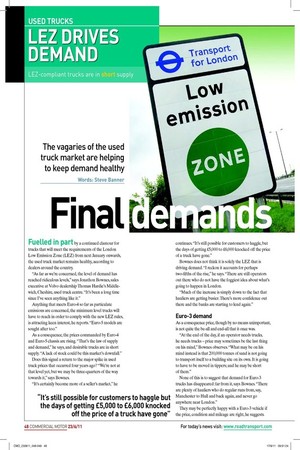Final demands
Page 42

Page 43

If you've noticed an error in this article please click here to report it so we can fix it.
The vagaries of the used truck market are helping to keep demand healthy
Words: Steve Banner Fuelled in part by a continued clamour for trucks that will meet the requirements of the London Low Emission Zone (LEZ) from next January onwards, the used truck market remains healthy, according to dealers around the country.
“As far as we’re concerned, the level of demand has reached ridiculous levels,” says Jonathon Bownes, sales executive at Volvo dealership Thomas Hardie’s Middlewich, Cheshire, used truck centre. “It’s been a long time since I’ve seen anything like it.” Anything that meets Euro-4 so far as particulate emissions are concerned, the minimum level trucks will have to reach in order to comply with the new LEZ rules, is attracting keen interest, he reports. “Euro-5 models are sought after too.” As a consequence, the prices commanded by Euro-4 and Euro-5 chassis are rising. “That’s the law of supply and demand,” he says, and desirable trucks are in short supply. “A lack of stock could be this market’s downfall.” Does this signal a return to the major spike in used truck prices that occurred four years ago? “We’re not at that level yet, but we may be three-quarters of the way towards it,” says Bownes.
“It’s certainly become more of a seller’s market,” he continues. “It’s still possible for customers to haggle, but the days of getting £5,000 to £6,000 knocked off the price of a truck have gone.” Bownes does not think it is solely the LEZ that is driving demand. “I reckon it accounts for perhaps two-ifths of the rise,” he says. “There are still operators out there who do not have the foggiest idea about what’s going to happen in London.
“Much of the increase is simply down to the fact that hauliers are getting busier. There’s more conidence out there and the banks are starting to lend again.”
Euro-3 demand
As a consequence price, though by no means unimportant, is not quite the be-all and end-all that it once was.
“At the end of the day, if an operator needs trucks, he needs trucks – price may sometimes be the last thing on his mind,” Bownes observes. “What may be on his mind instead is that 200,000 tonnes of sand is not going to transport itself to a building site on its own. It is going to have to be moved in tippers; and he may be short of them.” None of this is to suggest that demand for Euro-3 trucks has disappeared: far from it, says Bownes. “There are plenty of hauliers who do regular runs from, say, Manchester to Hull and back again, and never go anywhere near London.” They may be perfectly happy with a Euro-3 vehicle if the price, condition and mileage are right, he suggests. While Bownes does not believe that the used market is booming, Matt Hammond, used vehicle sales manager at West Thurrock, Essex-based dealership Harris DAF, says it has been healthy for most of this year, aside from a minor slowdown in May. Prices remain steady, he adds, but a shortage of retailable rigids is continuing to cause headaches, with everything from 7.5-tonners to 32-tonners thin on the ground.
“I’m inding it especially dificult to locate 7.5-, 12-, and 18-tonne curtainsiders that will meet the new LEZ regulations,” he reports. “If I had a 7.5-tonne curtainsider that did, I could sell it 10 times over. By contrast suitable tractor units are in relatively good supply.” “It’s a struggle to get stock, especially when it comes to rigids,” says Nigel Sharp, in charge of used sales at DAF dealership F & G Commercials, which has outlets in Barnsley, Huddersield and Oldham. He agrees with Hammond that units are easier to come by.
“All in all, I can’t complain,” he says. “Things have gone well since the start of the year; there’s still interest in Euro-3s for local work; we’re getting quite a few calls about the LEZ; and prices remain steady – although operators still like to shop around for the best deal.” Harris DAF recently invited more than 100 people to an LEZ presentation in a bid to ensure that operators in its catchment area understand what’s happening.
While many transport companies have yet to take action, some have decided to comply by itting their existing trucks with a suitable particulate trap, says Hammond.
“Remember though that if that is what you eventually decide to do, and you haven’t ordered yours by September/October time, then your truck may not meet the January 2012 deadline because traps are made to order,” he warns. “They are not stockpiled in a warehouse somewhere.”
“If you decide to buy a Euro-4 truck instead though, and again leave it until the autumn, then you could ind you’ve got just as much of a problem because there won’t be anything suitable out there,” adds Bownes. ■













































